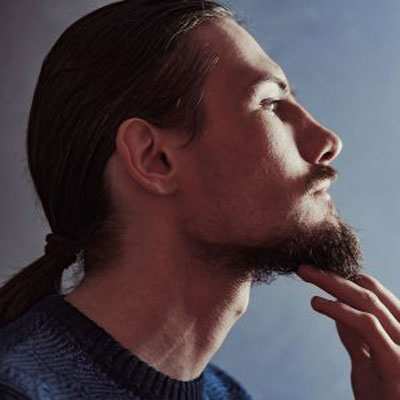Koteletten – 3 Tipps für Trimmen, Pflegen & Stylen
Koteletten - Ein zeitloser Klassiker mit modernen Interpretationen
Was haben Wolverine, Elvis, Kaiser Wilhelm I. gemeinsam? Richtig. Ihre Vorliebe für den absoluten Exzentriker unter den Bartstyles: Koteletten. Die einen finden sie antiquiert, die anderen halten sie für zeitlos und unfassbar elegant. Wie bei allen Bart Styles gilt: Alles, was dir gefällt und steht, ist ein guter Style. Wie du den perfekten Koteletten-Style für dich und deine Gesichtsform findest, wie du Koteletten richtig trimmst und pflegst und welche Fehler du vermeiden solltest, erfährst du in diesem Artikel.

Koteletten – Ein zeitloser Bartstyle in verschiedenen Varianten
In der Welt der Mode kommen und gehen Trends - doch die Koteletten erfreuen sich seit vielen Jahren anhaltender Beliebtheit. Die markante Gesichtsbehaarung hat nicht nur Geschichte geschrieben, sondern feierte in den vergangenen Jahren ein absolutes Comeback. Koteletten, im Englischen auch als "Burnsides" bekannt, sind eine besondere Form der Gesichtsbehaarung, die seit Jahrhunderten männliche Gesichter ziert. Im Wesentlichen handelt es sich dabei um längliche, dreieckige oder schmale Streifen von Gesichtshaaren, die vor den Ohren entlang der Wangen und des Unterkiefers verlaufen.

Aber Koteletten sind nicht gleich Koteletten: Dieser Bartstyle blickt nicht nur auf eine beachtliche Geschichte zurück, die bis ins frühe 19. Jahrhundert zurückreicht, sondern ist auch unglaublich vielseitig. Von klassischen Koteletten bis zu modernen Interpretationen – die Welt der Koteletten ist so vielseitig wie die Männer, die sie tragen:
Kurze Koteletten
Elegant und modern: Von kurzen Koteletten spricht man, wenn die Behaarung maximal bis zur Mitte des Ohres reicht. Dieser Style ist perfekt, wenn du dich erstmal herantasten möchtest oder ansonsten keine Gesichtsbehaarung trägst. Auch hier sind deiner Kreativität keine Grenzen gesetzt: Ob schmal zulaufend, angeschrägt oder breit entscheidest du. Dieser Style eignet sich besonders gut für Männer mit schmaler Stirn und einem relativ breiten Kinn.

Mittellange Koteletten
Diese Form der Koteletten sollte maximal bis zu den Ohrläppchen reichen. Diese Koteletten eignen sich besonders gut für eckige und kantige aber auch runde Gesichtsformen. Achte unbedingt darauf, dass die Koteletten nicht zu dick sind, denn sonst konkurrieren sie schnell mit deinen Gesichtskonturen. Als kleiner Richtwert kann dir die Breite deines Zeigefingers dienen.

Lange Koteletten
Lange Koteletten setzen ein Statement und wirken besonders maskulin. Voraussetzung ist natürlich ein ausreichender Bartwuchs. Ob schmal oder etwas breiter, kannst du je nach eigenem Geschmack entscheiden. Dieser Style rahmt dein Gesicht optisch und verlängert – die perfekte Wahl für breite, runde und viereckige Gesichtsformen.

Klassische Koteletten
Du hast Lust auf Koteletten aaaall the way oder willst einen extravaganten, maskulinen Look? This is the way to go. Klassische Koteletten eignen sich besonders, wenn du deine Wangenknochen betonen möchtest und unterstreichen gleichzeitig dein Kinn. Sie verlaufen vom Haaransatz über die Wangen bis zum Kiefer. Diese Form ist sehr lang und verläuft nach unten Richtung Mundwinkel breiter. Durch diese Form wird dein Gesicht optisch verlängert - die perfekte Wahl für runde und viereckige Gesichtsformen.

Die perfekten Koteletten in 3 Schritten: Koteletten richtig trimmen, pflegen und stylen
Bevor du deine Koteletten richtig shapen kannst, solltest du deinem Bart ein paar Tage zum Wachsen geben. Du hast die perfekte Koteletten-Variante für deine Gesichtsform gefunden? Perfekt. Dann kannst du dich jetzt ans Trimmen und Rasieren machen. Während man die Barthaare bei Koteletten früher möglichst lang und im Idealfall gelockt trug, solltest du dir heute auf jeden Fall einen guten Barttrimmer und einen Rasierer oder Rasierhobel zulegen, um einen einheitlichen und gepflegten Look zu kreieren.

1. Sauberes Trimmen
Beginne mit gewaschenem und getrocknetem Gesichtshaar, um optimale Ergebnisse beim Trimmen zu erzielen. Ein sauberes Haar ermöglicht es dem Barttrimmer, gleichmäßig zu schneiden, ohne durch Schmutz oder Stylingprodukte behindert zu werden. Du solltest dir auch auf jeden Fall Gedanken darüber machen, wie lang du deine Barthaare tragen möchtest: Lang und buschig, mittellang oder ganz kurz. Unsicher? Dann taste dich langsam heran und trimme sie, bis du dich wohl fühlst. Als Richtwert: Besonders gepflegt wirken Koteletten mit einer klassischen 3-Tage-Bart-Länge von 0,5-2,5mm.
2. Präzise Konturen
Für einen gepflegten Look ist vor allem eins wichtig: Präzise Konturen! Verwende entweder einen Barttrimmer, ein Rasiermesser oder einen Rasierhobel, um scharfe Konturen zu definieren. Falls du die Konturen nass rasierst, eignet sich ein Rasieröl besonders gut. Folge dabei der natürlichen Linie deiner Wangenknochen und des Unterkiefers.
3. Richtige Pflege und Styling
Pflege deine Koteletten mit einem hochwertigen Bartöl oder einer -creme. Diese Produkte helfen, das Haar geschmeidig zu halten, verleihen Glanz und verhindern das Austrocknen der Haut darunter. Trage das Bartöl auf die Koteletten auf und massiere es sanft ein, um die Haare zu pflegen. Eine Bartcreme kann verwendet werden, um zusätzliche Feuchtigkeit zu spenden und die Koteletten in Form zu halten. Je nach Länge der Koteletten kannst du auch etwas Bartwachs verwenden, um sie in Form zu bringen.
3 Fehler, die du bei Koteletten vermeiden solltest
Fehler 1: Deine Koteletten sind nicht symmetrisch.
Symmetrie ist entscheidend für einen ästhetischen Look. Achte darauf, dass die Koteletten auf beiden Seiten deines Gesichts gleichmäßig sind. Verwende klare Linien und schaffe präzise Konturen, um einen perfekten Look zu erreichen.
Fehler 2: Deine Koteletten passen nicht zu deinem Haarstyle oder deinem Bart.
Is it a match? Für einen harmonischen und stilvollen Look sollten Haare, Bart und Koteletten aufeinander abgestimmt sein. Zunächst solltest du natürlich deine Gesichtsform berücksichtigen, um einen Bart Style zu wählen, der diese optimal betont oder ausgleicht. Das Geheimnis von einem richtig guten Koteletten-Look? Pass deine Koteletten nicht nur an deinen Bart an, sondern auch an deine Frisur. Wenn du deine Haare akkurat trägst, solltest du auf kurze und weniger präsente Koteletten setzen. Trägst du dein Haar lang, hast du viel Volumen oder sogar Locken, darf es auch etwas mehr sein. Noch ein Tipp: Deine Koteletten sollten nie länger als deine Barthaare sein. Trust us on this.

Fehler 3: Fehlende oder falsche Pflege
Fehlende Pflege kann zu Trockenheit, Kräuselungen und unsauberen Konturen führen, was dich ungepflegt erscheinen lässt. Zudem können Hautirritationen und Juckreiz auftreten. Ohne regelmäßiges Trimmen verlieren die Koteletten ihre Form und Definition, während ein Mangel an Glätte und Glanz den gesamten Look zerstört.
FAQ
Woher kommt der Name Koteletten?
Der Name "Koteletten" für diesen Bartstil hat seinen Ursprung im französischen Wort "côtelette", das übersetzt "kleiner Knochen" bedeutet. Diese Bezeichnung bezieht sich auf die Form der Koteletten, die länglich und dreieckig sind und an die Knochenstruktur erinnern. Die Verwendung des Begriffs "Koteletten" für Gesichtsbehaarung entstand im 19. Jahrhundert und wurde im Laufe der Zeit populär. Eine andere Bezeichnung für diese Form der Gesichtsbehaarung ist ‘Burnsides’ (vor allem im englischsprachigen Raum), was wiederum auf Ambrose Burnside zurückgeht, einem US-amerikanischen General während des Bürgerkriegs im 19. Jahrhundert, der für seine markanten, buschigen Gesichtsbehaarung an den Wangen bekannt war.
Sollte man Koteletten schneiden?
Die Entscheidung, Koteletten zu schneiden oder zu trimmen, hängt von deinen individuellen Vorlieben, dem gewünschten Stil und deinen Präferenzen ab. Ein regelmäßiges Trimmen ist notwendig, um die gewünschte Form und Länge der Koteletten beizubehalten und einen gepflegten Look zu gewährleisten. Der Zeitpunkt des Trimmens hängt von der persönlichen Haarwuchsgeschwindigkeit ab, aber viele Männer wählen einen Rhythmus von 1 bis 2 mal pro Woche, um die Konturen sauber zu halten. Ein ordnungsgemäßes Trimmen verhindert, dass die Koteletten unkontrolliert wachsen und fördert einen gepflegten, professionellen Bartstil. Wenn es um die Pflege von Koteletten geht, ist es wichtig, auf die individuellen Präferenzen und den gewünschten Bartstil einzugehen.
Entdecke weitere Bartpflege-Artikel in unserer Academy
Related product

Brooklyn Blade
€ 89,95










